
 |
I was very much looking forward to October for two reasons, first it's prime aurora season and second we had a couple of interesting comets to look forward to. The main contender was C/2025 A6 Lemmon, this comet was only meant to reach mag+10 making it a telescopic subject only of interest to comet observers like myself however it seemed unexciting, it would just be another comet to tick off my growing list. Then during late Summer the comet emerged from solar conjunction and it was much brighter and more active than expected, this took scientists and comet observers by surprise and if it kept up it's rate of brightening it could become a faint naked eye object during late October. At first there was concern that the recent enhanced activity may have only been an outburst and if so it would be expected to fade to its previous level of brightness, however this was not the case. As David Levy said ''comets are like cats, they have tails and they do precisely what they want'', this was proving to be true for Lemmon!
The up tick in activity was real and persistent, furthermore the comet had been here before approximately 1300 years ago, such visitors with a previous history tend to be more reliable as their icy nuclei have already been exposed and processed by the sun, these returning long period comets tend to have more reliable brightness trends and furthermore if it was here before then the chances of disintegration were low, in fact, everyone was confident it was a healthy comet. An updated light curve was published showing both CCD and visual estimates with several outcomes. It looked like the comet could peak at mag +4 and perhaps even +3.5, more optimistic estimates were going for +2.9, whatever value it reached it would become naked eye and a very nice binocular object. Amazingly there was no hype with this one (thank goodness), the comet was behaving well and social media and click bait news outlets online seemed to not pay it too much attention to it or create silly names like they seem to do with most comets, such as 'the green comet' or 'devil comet' and so forth. The reason for this neglect was likely due to all media attention focusing on interstellar comet 3i/ATLAS, this hype for that one was and is getting completely out of hand, but more on that another time.
I was looking forward to following Lemmon, my expectations remained low, it was a gas-dominated comet so these tend to be less bright than a dusty comet of the same brightness, I was expecting a blue-green large fuzzball visible faintly to the naked eye with a short tail, the tail more of a prize for astrophotographers. However I was going to enjoy this new visitor and planned to observe it as possible to watch it evolve, at least it was something cool to look forward to. Lemmon would be primarily a pre-dawn object but would soon become circumpolar then move into the evening sky and would become fairly well placed in the W-NW during the peak of it's apparition at an elongation of some 50 degrees and for once mid latitude observers where well placed for observations, more so than anywhere else. Meanwhile another comet, C/2025 R2 SWAN was getting a lot of attention from southern latitudes, it was already a binocular object with a good gas tail and was turning out to be photogenic. This comet was actually discovered by a person searching imagery captured by the SWAN instrument onboard SOHO, SWAN is short for solar wind anisotropies and detects hydrogen around the vicinity of the sun, which means it occasionally finds new comets with hydrogen-rich comae. Comet SWAN would cross into the northern hemisphere by mid to late October and would provide us with the rare opportunity to observe two binocular comets at the same time.
On the morning of September 21st I got up during the early hours to a clear dark sky and set up my 10" F/5 reflector at 03.30 to find Lemmon. It didn't take long at all, I found the comet in the NE between Cancer and Lynx at mag+7.8 as a circular fuzz ball with a DC of 5 and no tail seen due to poor transparency, it felt great to finally see it, this was my 96th observed comet. I observed it again on the 22nd and 25th, moderately condensed with a healthy looking condensation and now I could see 50 arc min's of blue gas tail. On the 28th it had moved further east and I could see it in 10x42mm binos with a blue-green coma. On October 6th it was in the N passing below the paws of the Great Bear at mag +6, easy in binos and had the sky been less cloudy I would have tried for it with the naked eye. After this the N. Ireland weather done exactly what it did when T-ATLAS appeared this time last year, it turned unbelievably cloudy!
During this period we strong had high pressure rite over the UK, and I knew what way it was going to go, it would be what forecasters call 'anti-cyclonic gloom'. This meant every single night was cloudy, and with no wind around the cloud just sat over Ireland for days, low humid cloud with mist and even mizzle at times, it was an absolute disaster. Meanwhile the comet brightened rapidly and was already brighter than mag +5, then a major geomagnetic storm happened and those with clear skies over Scotland, E Europe and America got to capture the comet with it's tail within the aurora, some of the images online were amazing. I've captured a bright comet with NLCs before (NEOWISE 2020) however I have always wanted to capture a comet with aurora, and now it happened, and yet we were under 100% cloud cover for the entire event. High pressure remained firm for over a week then a change happened, low pressure would move in bringing a more dynamic pattern, I was hopeful this would bring clear skies, but no, fronts and troughs all merged together bringing cloud once again for days on end. Eventually there was light at the end of the tunnel, some models were forecasting clear spells for October 19th and I was ready to make the most of it.
Models showed clear spells for this night, the batteries were charged and the telescope was packed in the van. The models all showed an evening clearance with the north coast being the best place to be when darkness arrived, I mean every single source was showing this, even the television forecasts which I never rely on. I had planned on meeting Nigel McFarland and Colleen Webb at Benone beach with the anticipation of a dark clear calm night under the stars at the beach where we would observe the comet at our leisure, I was excited. I saw a clearance to my south behind the front advancing north and everything was falling into place nicely, I drove to the north coast chasing the front and hitting drizzle but I wasn't concerned as the clearance would be catching up with me shortly. I arrived at Benone beach and didn't like what I saw, there was no clear skies anywhere, nothing, not one star, it was already twilight and the clock was ticking, I began to feel the pressure, that clearance never appeared, it was gone, how could all the forecasts have got this so wrong?, I waited over an hour hoping for the best, but nothing, it was a complete bust and a wasted drive which took 1.5 hours to get here. I was fuming and in a really bad mood, what a waste of time and yet another let down which seemed to sum up most of 2025. I got back in the van and began driving back.
Along the coastal road Colleen Webb passed me, I pulled into the layby near Bishop's Tower and waited, she had spotted me, rang to confirm, then drove to meet me. We stood under the overcast sky with low stratus clouds wondering what to do. We complained and wined, the sky was hopeless, sat imagery showed cloud everywhere with the north coast being the worst, it was game over. We decided we would drive back home inland and if we spotted a clear break we would pull over but our confidence was low. We both drove back home feeling defeated, then suddenly between Coleraine and Garvagh we saw clear sectors out of nowhere, we pulled into a picnic area and got out for a look, we weren't even properly dark adapted, trees blocked the west so I grabbed the binos and Colleen and I ran across the busy road into the entrance of a lane which led to a farm house, we didn't want to stay there long as we looked suspicious but it offered us a break in the trees. A quick sweep with the binos and there it was!, between Canes Venatici and Bootes, it looked like a fuzzy star, then I excitedly said I can see a tail!, then with the naked eye I cold see it once I knew where to look, it had 1 degree of naked eye tail (two apparent full moon diameters), we were buzzing, I was just happy to make a visual on it, the comet was much better looking since I had last seen it.
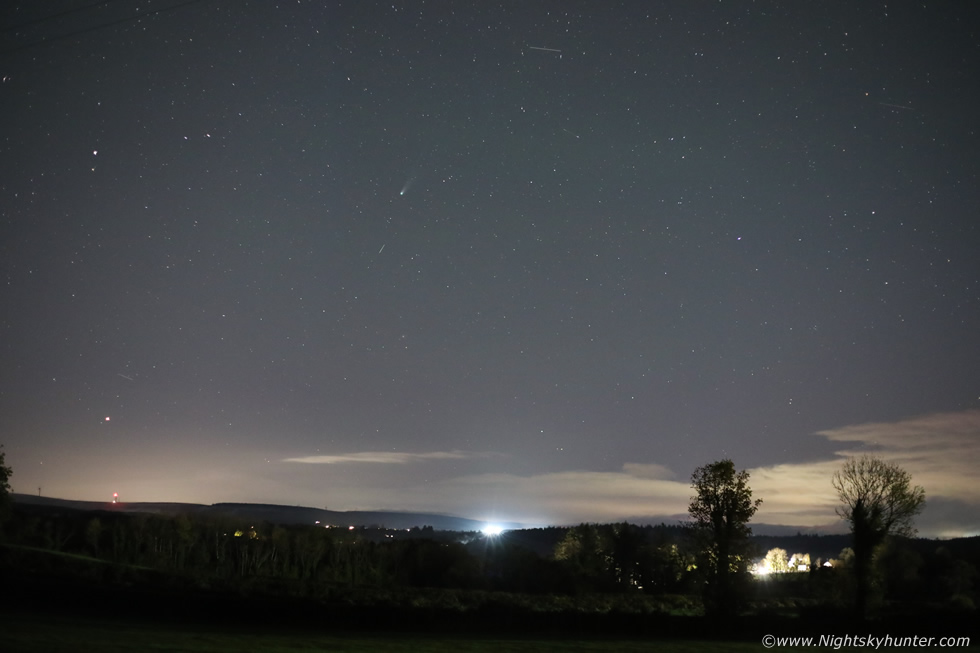 |
We ran back across the road then moved more inland and as we did so the clearance got much bigger, we had made the correct decision doing this, I just wanted to get observing it and obtain an image rite away. We pulled into the layby outside Garvagh and Colleen and I where straight out setting up the cameras. In the midst of the excitement, rushing about, and with the concern about more cloud moving in it's amazing how you can mess up doing small things which you have done a hundred times before with ease. I struggled to get the camera on the tripod, it just wouldn't fit into the base plate, valuable time wasted, then I struggled focusing the 50mm lens on the full frame, this is a common issue with this lens, every time I got focused on a star and moved the tripod to aim for the comet the lens would go out of focus again, very frustrating, but eventually I got it sorted and Colleen was shooting exposures at this stage too. No points for photography here, light pollution, no foreground interest, and we were shooting under low hanging power lines but at least we got a record of it, the tail came up well, I suspected it was a beauty in the telescope so I forgot all about cameras and set-up the 10" F/5 reflector.
This was proper road side astronomy, cameras shooting, binos watching the skies and now I had my Dobsonian set up at the side of a very busy road with the passing headlights from cars and trucks blinding us. When I looked into the eyepiece I was blown away, Lemmon was a proper comet!, even at a casual glance it had a large bright condensation, jets within that condensation, a compact DC:6/ coma and blowing downwind was a long and beautiful gas tail with several streamers fanning from the coma into the tail. The tail itself looked alive as if it was glowing against the background sky, I could trace the tail for at least two degrees. We were buzzing from seeing it and felt the rush from the chase, this was turning into quite the adventure, from the coast to inland from cloud to clear skies, a proper emotional roller coaster ride. We decided to take the chance and head to Glenullin wind farm hoping it would still be clear, we just needed peace away from the cars as the lights were messing with image potential so off we went.
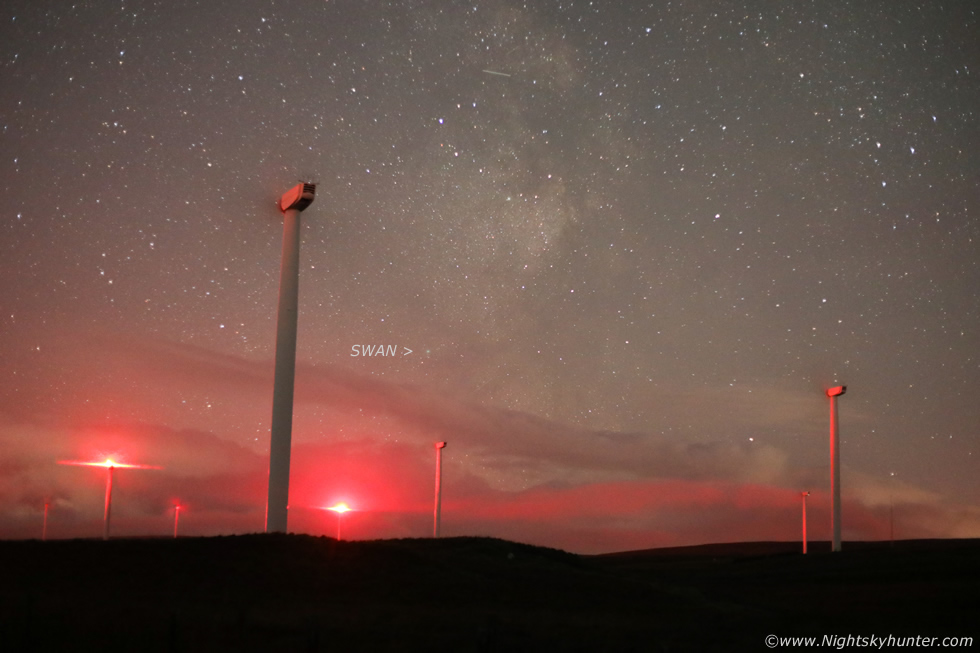 |
The sky was perfectly clear at the wind turbines, we where on high ground and above the fog which was hiding the stars from low ground. The sky was so much more dark and it was peaceful and quiet. The scope was back out and so where our cameras, Lemmon was behaving itself but I remembered about comet SWAN which was now visible in the low west at the same time, I wanted to tick that one off my list. I swept the milky way with the 10x42mm binos and within less than a minute I found comet SWAN, there it was within Scutum the Shield as a large round fuzzy haze. While Lemmon was compact and condensed SWAN was the opposite, large, tailless and diffuse, it just shows you how much each comet can look different from one another. SWAN was mag +5.7 and almost half the size of the diameter of the full moon at 13 arc minutes.
In the telescope it looked beautiful in it's own way, a large haze with condensation (DC:4) which looked vivid green perched against a backdrop of dense stars and milky way dust clouds, this was my 97th comet, this was turning into a very successful evening. I took an image of this sector of the milky way using the 50mm F/1.8 lens on a full frame Canon 5D Mark IV with the turbines. I actually shot a short time lapse of this scene, my first night lapse in a very long time due to a cloudy year. In the frame are the rich milky way clouds from Aquila into Scutum, I have marked SWAN on the image, it actually came up well as a fuzzball.
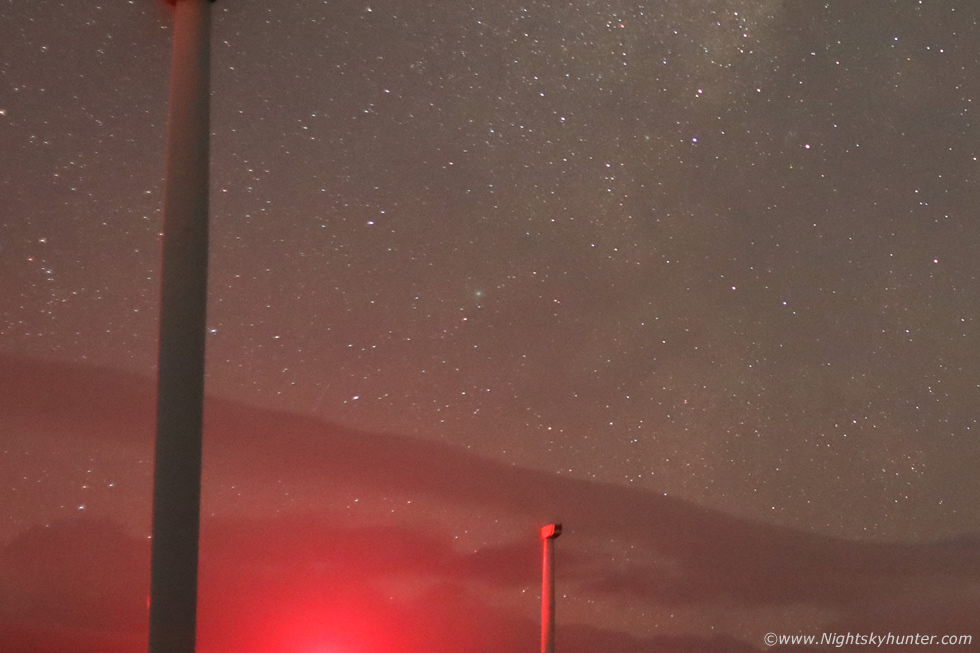 |
Deep crop from the above image showing green SWAN, it would have been moving at a fairly fast pace to the east (left) each night as it was making its closest approach to Earth. In the telescopic field I could see the large dark turbine blades sweeping through the FOV with the comet at centre accompanied by an audible swishing sound. I had a long detailed looked at Lemmon again in the 10" savoring every second of it's light, it was starting to drop fairly low in the NW into an area of increasing haze and distant LP. To be honest the comet wasn't big enough for our 50mm lenses to do it justice, it really needed a telephoto lens on a skytracker to do it justice, but we wanted an image to take home for the memory.
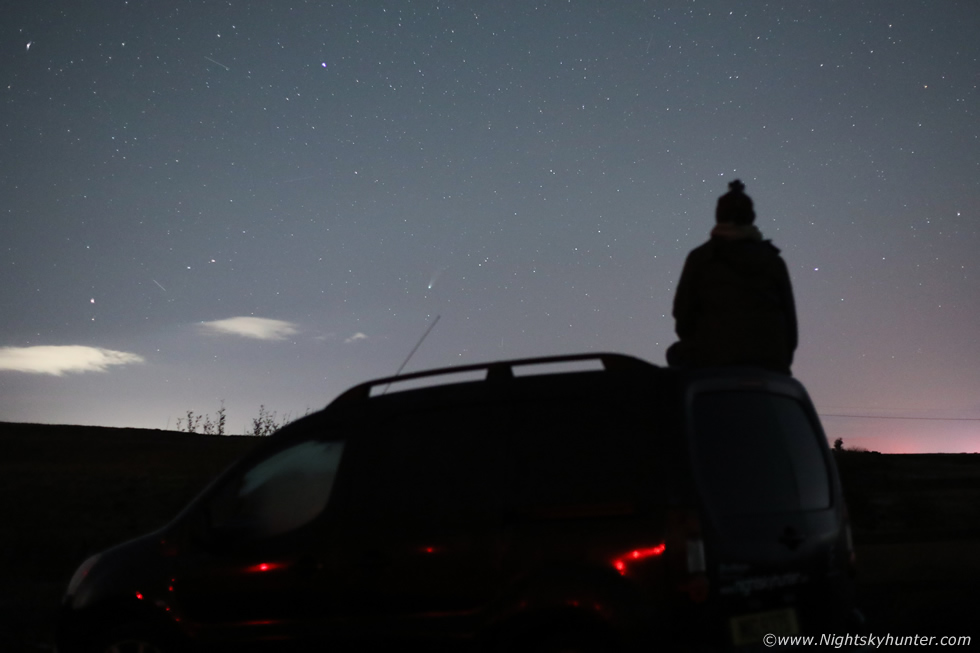 |
With no foreground I just set up my camera and climbed onto the van roof to get a selfie with the comet, Lemmon above the aerial, if you look carefully you can see the gas tail extending for several degrees. Colleen got her own selfie images as the comet dropped towards the horizon. The night had been a success, I had a brew to warm up then we called it a night at 23.00, the forecast hinted at clear spells the following night so we would be out once again.
I was looking forward to October 21st, this would be the comet's closest approach to Earth and hence at its brightest, also this time coincided with the peak of the Orionid meteor shower which meant the prospect of seeing a comet and meteors from Halley's comet all on the same night. The weather would cause a headache once again, at first the models showed good clear spells but they updated in the afternoon showing more in the way of cloud, the UKTV showed a few breaks in the Swatragh area once again so we decided we would take the risk and go there. This time we would be meeting Nigel McFarland who was eager to see the comet. I left Cookstown under clear skies, in fact, it was clear everywhere, the forecast had been wrong again, but as I drove to Swatragh I could see a row of shower clouds over the Sperrins feeding across our target area, the only place that had cloud!, but I could see clear skies behind the showers and felt confident it would clear after dark. I arrived at Glenullin wind turbine farm again and soon after Nigel arrived, we where chatting when a break appeared to the NW, it was bright twilight and not even dark yet, I found the comet easily in the binos and also with the naked eye fairly easy at mag +4, tonight the comet was located within Bootes and to the far lower right of Corona Borealis, it had moved across a fair bit of stellar real estate during the 24 hours since we last saw it.
Colleen arrived and we waited and chatted, it was cold but the breeze gave us confidence it would shift the clouds. At first we were concerned we were going to be clouded out but after an hour the sky cleared completely and the sky was beautiful with decent clarity, this would be our best chance to experience the comet yet. The red lights were out on some of the turbines to the west so the sky seemed even darker tonight. I went straight to the telescope and had a long look at Lemmon. The sight in the eyepiece was simply gorgeous, the coma was blue in colour, rounded and compact and well condensed at DC:7, the central condensation was intense white and very active, it had diameter like a disk and lurking inside was a fuzzy false nucleus, at least two dust jets could be seen with one bright jet pointing in the anti-solar direction. There was a green envelope on the sunward portion of the coma. Two tails could be seen with ease, the dust was uniform and bright, extending for 2 degrees and running adjacent to it was the blue gas tail which I could trace to 2.5 degrees. The two tails had some degree of separation but overlapped in the region near the coma. There was a long straight bright spine extending through the gas tail, it may have been a long bright streamer. Overall the comet with it's blue tail was absolutely gorgeous, I noted the position of a bright field star near the coma and half an hour later I checked again and was shocked to note how much the comet had moved among the background stars, likely in the 50-60km/second range.
Nigel had a good look in the telescope and soaked it all in, the best view was through the wide angle 26mm 2" SWA eyepiece. Colleen was also observing it in her 6" reflector and Nigel concentrated on getting images using his 100mm lens. We were all occupied with our own thing, lost in the enjoyment of the night. The comet was easy with the naked eye, the dust tail could be seen 2 degrees long without optical aid where it merged into the background sky with the naked eye stars in central Bootes. I was extremely well dark adapted and had a steady look in the binos, the visual impression was similar to what others were getting on images, two tails, but the gas tail could be seen for 5 degrees or 10 apparent full moon diameters. This really was a beautiful comet, it was no NEOWISE or T-ATLAS or Hale-Bopp but it was never expected to be, Lemmon was performing well and in fact it looked a lot more impressive than I had expected, I really was starting to enjoy this comet in a major way and knew it required more dedication each clear night to watch it develop. I was happy with the visual observing so I grabbed my camera and walked away to get images.
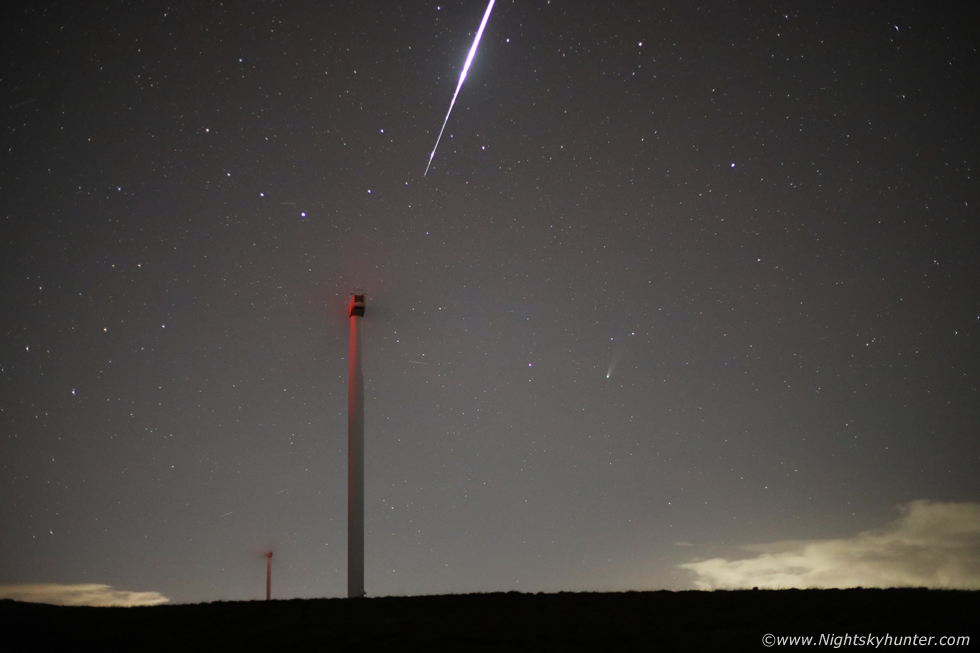 |
I walked into the grounds where the turbines towered overhead, set up the 5D with 50mm lens framing the comet with one of the turbines and began shooting a time lapse. I let the camera do its thing and walked back out onto the dark road to enjoy the sky. I was watching the comet when suddenly a dramatic fireball blazed across the sky from an acute angle high in the east, it's head was like a large silver diamond with a long orange tail, the fireball flickered several times and cast shadows on the ground before vanishing. I let out a yell of delight, I reckoned it was mag -5 but in hindsight I may have underestimated it, duration was for 3 seconds, a real beauty, it ablated within northern Bootes above the comet, I suspected it would have been above the 50mm camera field. I waited for half an hour then decided to go back into the field, stop the time lapse and take a look, I wasn't expecting to have captured it at all, but there it was!!!
I was absolutely delighted, I had captured a fireball and comet on the same image, something I had never done before, in fact, the fireball upstaged the comet, the two phenomena looked great in the same field with Corona Borealis, the only thing missing was the eruption of blaze star TCrB to complete the scene. Meteors and fireballs come from the tails of ancient comets, so to get a comet and fireball together is special. The Orionid and Taurid radiants didn't line up with it's angle of entry so I considered this to be a sporadic fireball, it completely made my night.
 |
Crop framing comet and fireball
 |
The exposure after the fireball revealed a glowing ion train in it's wake, 'meteor smoke' - tiny dust particles dispersing in the upper atmosphere contributing to the material which generates Noctilucent Clouds during Summer nights.
 |
Lemmon from the road with gas tail faintly extending to the one o'clock position for several degrees
 |
I ended the night with a wide angle time lapse of the milky way over the turbines. I observed a few deep sky objects with the 10" such as M31, NGC404, M11, M27, M13, M92, M33 and of course a binocular check on TCrB. After 23.30 we ended the session, yet another successful night, I was now addicted to the comet and wanted to see it again, once home I would be going through the models to anticipate when I would next see it.
 |
The following day I made this sketch from memory of the comet as seen in the 10x42mm binos, even though I have cameras there's nothing more special than recording your observations and attempting a sketch, the process teaches you patience and improves your observing skills, the sketch would end up in my log book, I have been recording comets and sketching since 2000, I now have ten large log books full of observations like this one.
It had been cloudy since my last view of the comet and I was eager to see it again, October 23rd looked mostly cloudy on the models so I had ruled out seeing Lemmon once more, however Roisin and I had some personal things to attend to in Co. Antrim that evening. I didn't bring my camera at all however on an instinct I brought the 10x42mm binos and a book from my collection on observing comets, Roisin had a meeting to attend to so I would have time to myself to read. Unfortunately our location was near the airport just north of Crumlin so light pollution would be a concern. As we drove towards Antrim I saw a big clearance approach from the west which wasn't forecast, yet again the forecast and models had been wrong, the clearance looked good and was moving our way, it was already bright twilight, I dropped Roisin off and headed in search of darker skies, I didn't know the area so just drove into the countryside, I arrived at a small village called Killead, I spotted a church and drove into the grounds, by pure amazing luck there was a large car park at the rear which offered a clear view to the W-NW and the lights were all turned off, the car park was very dark, I couldn't believe my luck.
I parked parallel with the comet, it was a cold night with a keen wind blowing, so I put the window down a little, turned the car off, got dark adapted, then rested the binos on the window edge and observed from the comfort of the car. I ended up having a splendid unexpected session with the comet, no cameras, no telescope, just the binos, this would be an entirely visual session, something which I had craved, it was back to old school observing and enjoying that experience. I watched the comet constantly for an hour from 19.20 to 20.20 while close range planes took off and landed at the airport beside me. The coma was parabolic in shape, strongly condensed at DC:7/, green on the sunward side, the coma was swept back by the solar wind into a broad bright dust tail which was curved on the western side. The gas tail was superimposed on the dust and extended up and slightly away from the dust at a slight position angle. The gas tail was blue with very fine streamers, dust 2 degrees 20 arc minutes, gas 2 degrees 30 arc min's, I knew the fainter outer extension of the gas tail was hidden by light pollution from this location, but even so I was amazed how much I was seeing, and it was easy with the naked eye with 2 degrees of tail.
I watched it constantly, pondered about comets, life on Earth, and catastrophic impact events in the past, and detected the comet's motion against the background stars, once again the comet seemed alive to me, I felt like I had formed a connection with it due to the intensity of the observing session. I also found SWAN again near Capricornus, checked TCrB and M13, M92 and M31. High cloud came in so I turned on the internal light and read my book about comets for half an hour, I was having a great time to myself. Roisin rang so I picked her up at 21.00, she was expecting me to be moaning about sitting in the car bored killing time but was shocked when I said I had clear skies and was observing the comet for an hour solid.
 |
Log book entry the following day with the binocular view sketch on the left from the intimate night with Lemmon near an airport in Co. Antrim. If the comet looked this good then it must look even better from a dark sky, I was eager yet again to get another clear evening, this time back under the dark skies of the Sperrins. The comet was gradually moving away from the Earth but it was also getting closer to the sun every night, perihelion was November 8th, so this sunward motion would off set the drift from Earth and because the comet would be experiencing greater heat from the sun it should become even more active and strongly condensed, I had a feeling the best view of the comet was yet to come.
The forecast was looking clear and a shoot was arranged with great anticipation, we had our eye on this day several days in advance as the forecast looked decent, a post frontal air mass with clear skies and scattered showers. Paul Martin, John Fagan and I had planned on meeting at Davagh Forest at 19.30, we wanted to catch the comet in a clearance within the forest over the tree tops, we were all looking forward to this observing session. I left a little earlier as I wanted to see the comet from bright twilight onwards but I was concerned about the weather, it was wrong yet again, a common theme this month. All television forecasts were going for clear skies however the UKTV updated last minute showing much more in the way of cloud with just a few random gaps, any other time I would not go after seeing that, but this was a comet, it's special, we knew the chances of being clouded out was moderate, however we are optimists and were going to give it our best anyway.
I arrived in Davagh forest under complete cloud cover and things didn't look good, then a break appeared revealing the handle of the plough, it was then I realized our calculations were wrong, the comet would be hidden behind tall trees, it was more W than NW so our foreground wasn't going to work, this was a dilemma, where to go at such short notice?, then I saw a huge clearance coming in from the W, this might be my only chance to see the comet, so I got back in the van and raced back along the road and pulled into a small layby looking across the Sperrins. The sky was 70% clear with fabulous transparency, I grabbed the binos and got out for a look, I found the comet within seconds to the west of Serpens Caput and it was well placed high in the sky, at a casual glance I could see 7 degrees of gas tail, the comet looked stunning, I was shocked to see the tail going straight up and touching the naked eye stars in Corona Borealis, Lemmon had developed rapidly since my last sighting, the difference between the Antrim sighting and this one was night and day, the comet was just stunning and seeing it from this dark location took the experience to another level. I set the binos down and there it was naked eye with at least 5 degrees of tail, and the sky wasn't even dark yet!
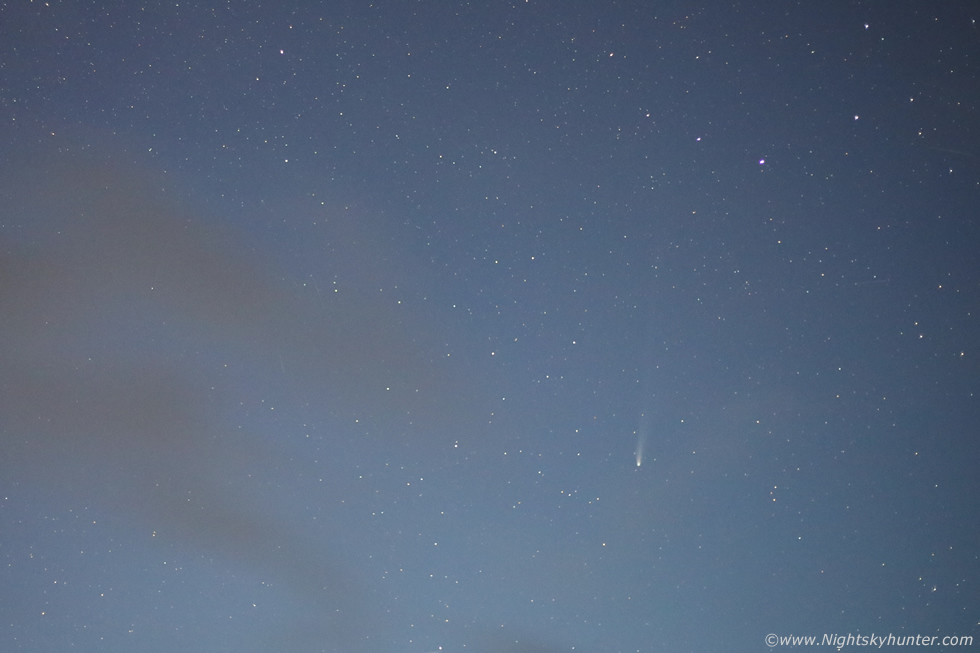 |
I knew the clear sector could fill in soon so I got the 5D Mark IV and 50mm lens attached and set-up the tripod on the middle of the country road and took several exposures. The camera confirmed my visual impression, tail touching CrB and furthermore it seemed to have a kink or slight bend in the upper portion of the plasma tail, no doubt a disturbance caused by the solar wind or perhaps even the beginning of a disconnection event, that was really cool.
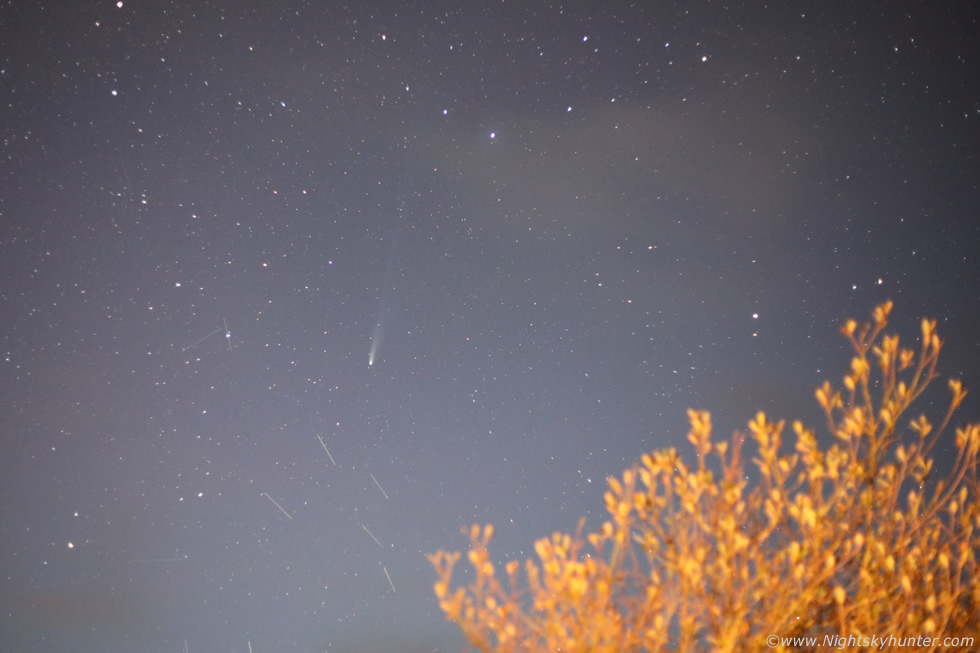 |
I needed foreground, the telegraph poles were annoying me so I drove on down the road and came to the T-junction and took the narrow country road to Broughderg. I stopped in the middle of the road beside some trees, I hoped no other cars would come along but this really was the middle of nowhere. I left the dipped lights on and framed the comet with the tree tops, the lights turned the tree golden-orange, I decided to keep this one as it had that Autumnal look. All those trails are satellites, the majority of which are Space X, I was horrified to see that almost every image I took of the comet during its entire apparition had starlink trails, these are a major source of pollution which are ruining our images of the night sky. There was nothing I could do about it though, every image had trails, I could have took fifty exposures and it would be the same result, even in the binos I saw the satellites, moving across the field and over the comet as drifting stars, there are nine trails on this image alone. Despite all this I tried to ignore them, it was the comet that would be getting all the attention.
Cloud moved back in, but before it did I turned to the SW and using the binos found C/2025 R2 SWAN, an easy to see large round green haze, two comets in one clearance, I was buzzing. The sky turned completely overcast and the atmosphere was dark and moody, I was concerned it would be cloudy for the remainder of the shoot so I was grateful I got this much. I realized I was behind my time, I was caught up in the moment, I needed to meet the guys so I drove back to Davagh forest where John and Paul where waiting. I informed them about my sighting and they could tell I was excited about the tail, I showed them the images, they were very keen to see it for themselves, as far as I was concerned I already got my images so anything else would be a bonus but if it stayed cloudy I would feel bad they didn't get their own images for the memories. Davagh wasn't working anyway so a consensus was made, we would go to Beaghmore Stone Circles.
We drove to Beaghmore, the sky was completely overcast and dark, everyone was highly motivated and sharp, we didn't fancy our chances with this cloud cover but we were prepared to capture it in any lucky breaks which appeared in the cloud cover. We wasted no time, grabbed our binos and cameras and walked into the pitch black stone circles. We all wanted an image of the comet over the tree tops at the west side of the area so we set-up facing the trees, cameras ready and waited. A few random gaps opened up, to the S, then E and overhead, even to the N, however cloud remained over the W. We got our cameras focused on any available stars then began sweeping gaps with the binos. We waited and waited and waited, it felt like forever, cloud was always over the comet, you couldn't have made it up, yet everywhere else was clear. Most others would have gave up but we were determined, resolute, dedicated, disciplined, passionate, we were going to stick it out to the end just for that one little gap. We began to get concerned that by the time it cleared the comet would have set.
We waited and waited, then small breaks, stars to the NW, those breaks slowly drifted W, we began to get confident we would score, patience and alertness were required. All three of us had our binos scanning above the tree tops, then all three of us saw it at once, there was the comet! a beautiful condensed coma and a quarter of the tail, the rest was obscured by cloud, as the cloud drifted slowly past the long tail seemed to play peek a boo as it bobbed in and out of view, we were loving it, the tail almost seemed to glow like a search beam from this dark location and with our highly developed dark adaption the comet seemed bright and impressive. A better clearance, the gas tail filled the 7 degree FOV of my binos, I panned them up following it, my estimate was at least 9 degrees of tail or 18 apparent full moon diameters, this was our best view of the comet yet, what a sight. I looked with the naked eye, I was astonished to see 9 or even 10 degrees of tail with no optical aid, going right up into the northern crown, the tail was the same as my fist held at arm's length, this is approximately 10 degrees. I was quite blown away by this, the comet was much better than any of us had thought.
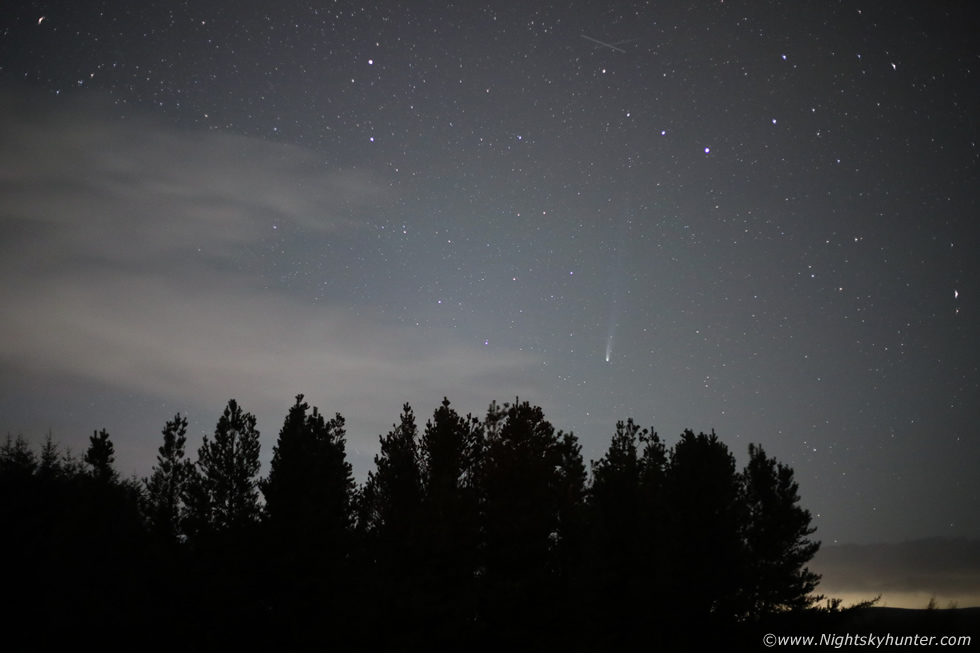 |
A proper clearance moved in and we put the cameras to work. All three of us become engrossed in our own worlds, John and Paul were busy with their own cameras and feeling the rush to capture the comet while the going was good. The images which followed would turn out to be my best of the comet, this period of October 25th to the 27th seemed to be the comet at its absolute finest. This is 50mm F/1.8 on full frame, ISO6400 for 6 sec's untracked. The image presented is the full 50mm FOV showing Corona Borealis, Serpens Caput, sections of Ophiuchus and southern Hercules and eastern Bootes. Lemmon extends from western Serpens into the principle stars of Corona, in fact, the tail almost points to the famous variable star and reverse Nova RCrB. Look carefully and you can make out the classic blue colour of the comet's gas tail, the scene is almost like a miniature Hyakutake.
 |
Another exposure cropped in slightly, this was the same time I was seeing approximately 10 degrees of naked eye tail and at least 9 degrees in the binos. Silence descended as John and Paul busied themselves with photography, occasionally the silence was interrupted by excited remarks about the tail. The going was good so I decided to begin shooting a time lapse, my intention was to capture a time lapse movie of the comet setting over the trees.
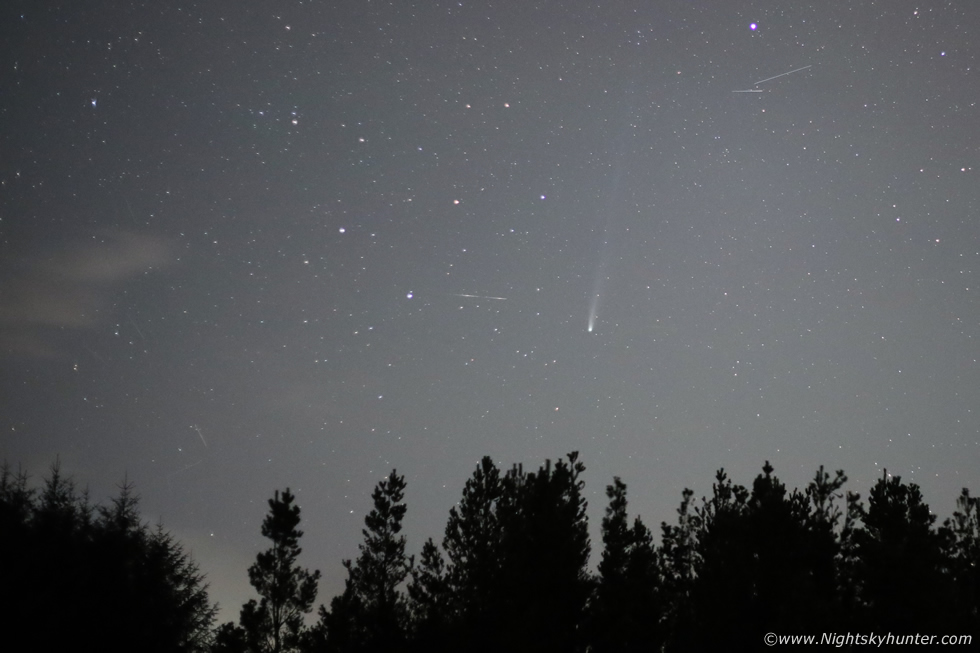 |
One more exposure cropped in deeper. My camera began taking images for the time lapse and now I could step away and enjoy the sky visually in peace with the binoculars. I scanned along the ghostly blue tail, I don't know how to explain it but there's something about comet tails, they are just mysterious and magnificent, it almost looks like the comet is alive, and in some sense it really is, the activity within a plasma tail can change within minutes, a comet is a dynamic object, constantly changing and transient in nature, a fleeting visitor. To think that objects like this are billions of years old and pre-date the formation of Earth, and that comets delivered water and organic compounds to the early Earth and might even have been responsible for the formation of our oceans and perhaps even sowing the seeds for life itself. Furthermore comets may have been responsible for cataclysmic impacts which caused extinctions and affected the course of evolution and that some day in the future a comet like this could strike our planet threatening our very existence, and here is one of them, passing us by at 40-50 times the speed of a bullet looking beautiful and majestic.
With the binos I had a quick look at M31, M33, SWAN, M15, double cluster and M11. Then the clouds rolled in once more completely ruining my time lapse, typical, I had to delete most of the images but kept these few stills for the memories. However all said and done we couldn't complain, we had a great visual experience and got images for the record, I felt proud we stood our ground and never gave up, we got rewarded with these brief breaks and in that time I experienced my best memories of C/2025 A6 Lemmon.
The next opportunity for clear skies came long on October 29th, however the forecast was far from great as usual with just a few clear gaps expected. The comet was now located between Serpens Caput and Ophiuchus and getting lower, the next issue was we would have a first quarter moon in the sky low in the S-SW and it would remain visible until comet set, which meant some of the tail could be washed out. As an extra bonus a solar wind stream was buffeting us so there was a prospect of some kind of aurora activity, I was hoping to get both at the same time to tick that rare event off my list. John Fagan and I agreed to meet at Beaghmore once again at 18.30, the clocks had gone back one hour so it was getting dark early. Before I left the charts showed the Bz diving south -10, I felt we had a fair chance at an aurora. I left the house a little later than I wanted and got stuck in rush hour traffic but when I got into the countryside I made good progress and made it to Beaghmore on time.
First game two concerns, once again it was very cloudy, second there was serious light pollution problems. The GAA pitch at Greencastle had their lights on completely destroying the western sky, lights so powerful they cast shadows on the ground here all the way from the Tyrone/Donegal border area. This meant our chances of getting proper images were finished, it really is a disgrace as those lights are destroying a dark sky site, they have been on for years and the issue hasn't been addressed and nothing was done about it, how sad that a few footballers get to destroy the night sky for everyone, all that was needed was either a change to modern light designs or light shields used to stop the lights going up and around, but there's been no interest in addressing this problem, we are stuck with seeing night suns during the dark evenings at this time of year. There was nothing to be done but adapt and make the most of what I had.
 |
I saw random clear breaks approaching from the NW and soon spotted the comet in the binos, much lower than the last time, once I knew where to look I could see it with the naked eye using averted vision, mag +4.0 or perhaps +4.2, but I was delighted to see the tail so easily, 5 degrees of naked eye ion tail even with moonlight present. The tail looked like a glowing thin straight streak of light connected to a fuzzy star, I was honestly surprised to see it so easily. I got the 10" set up fast and began observing. It was all go, scope, binos then camera, I grabbed a few quick images, it was still twilight at this stage. Here's Lemmon between passing cumulus clouds lit by the lights.
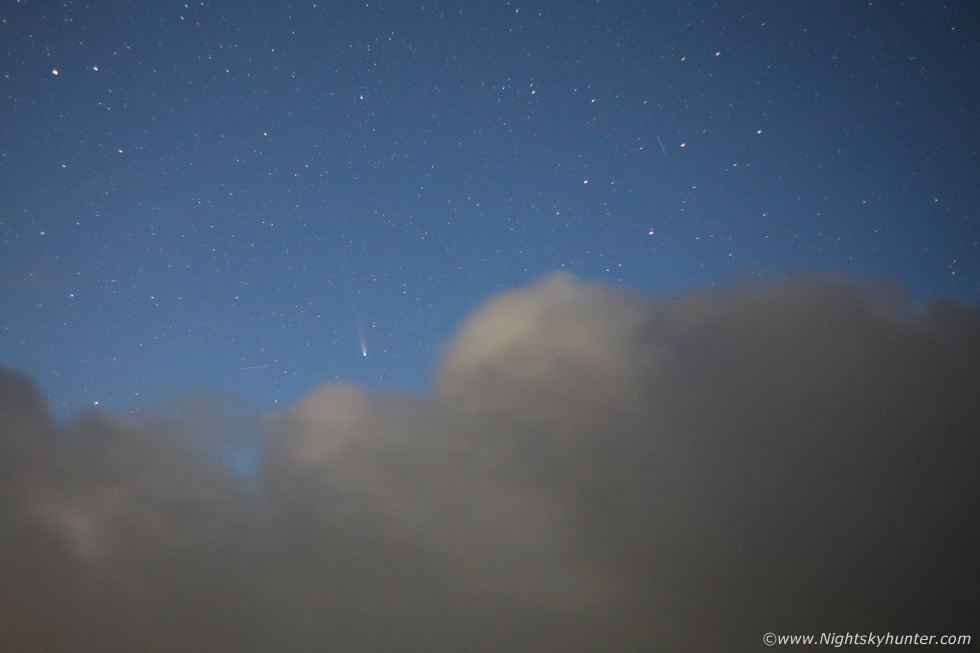 |
John arrived and we got to work, he had his binos and 10" reflector out and we ended up having a great session observing the comet together commenting on the coma and tail. We just waited for the comet to appear from behind clouds and our eyes were back at the eyepiece. In the scopes we also observed a selection of Messier objects then returned to the telescope when the comet appeared once more. I tried for a faint comet called T1 ATLAS within the handle of the plough however the transparency was poor in that area, my scope had also been knocked out of alignment from driving over bumps and as such stars looked more like blobs than points of light, I would worry about it another time.
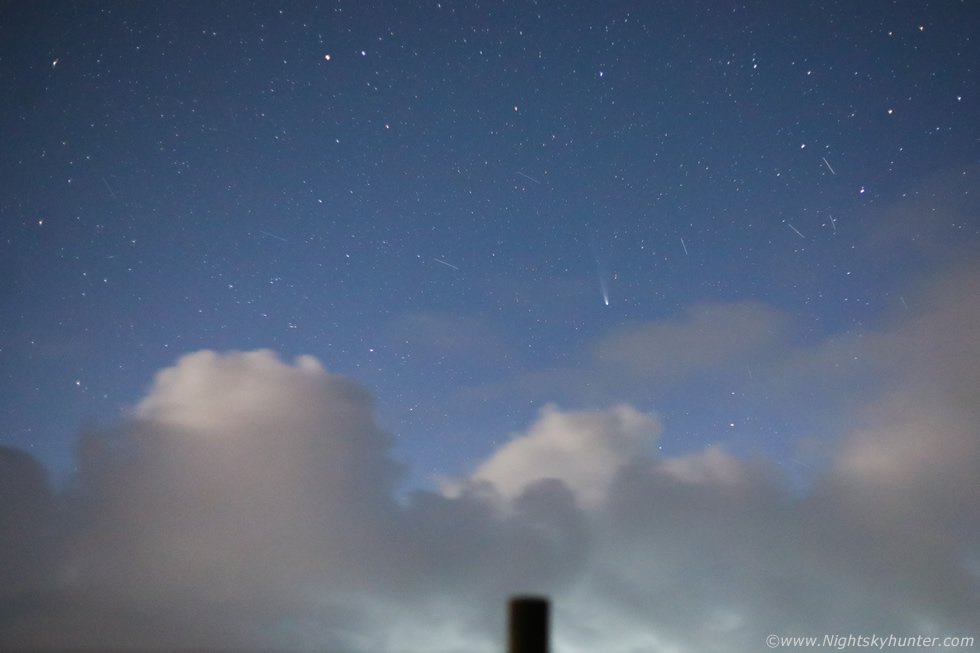 |
Another image as the sky got darker, excuse the fence post in the frame, that was from the fence at the car park, the comet was getting much lower. Thanks to Starlink for the ten trails in the image. All this shooting made me realize several things, I needed a better 50mm lens for full frame, this one was Ok but focusing is an absolute nightmare, also when you have the aperture wide open you get bad coma and vignetting, the corner shadows are notable and stars away from the centre become blops and those near the edge have wings, but what can you do, an expensive 50mm would cost hundreds of pounds, as much as a new camera, but I badly need one. For bright comets I also need to get a sky tracker to track the comet, reduce trailing, and allow for longer exposures at a lower ISO and stacking which would reduce noise and detect more detail, this is still on the wish list. Finally I was seriously considering getting a Seestar in the future, I had seen the results from other photographers of the comet and I was impressed, a really fancy piece of kit, it's on the list too.
 |
Despite the LP from the distant lights I jogged into the stone circles and got behind the tree tops for one final image before the comet set. 50mm and cropped a fair bit here. This was my final naked eye look and final image of the comet, farewell Lemmon!. On the nights ahead it would get lower and the moon brighter so tonight John and I got what we wanted, a final look at this beautiful comet from a dark location, observed in peace and solitude, an intimate experience, just what we wanted. In conclusion, comet Lemmon surpassed my expectations, it developed dust and gas tails with the latter being much longer and more obvious than I ever expected. It reminded me a little of Ikeya-Zhang in 2002, perhaps better, it was photogenic and the visual view was stunning. Most important of all it provided us with much excitement and joy during the month of October and that rush to hunt something special and transient in the sky and the battle with the clouds just added to the overall experience.
Lemmon won't return until more than 1000 years, I won't be around to see it, however my next target will be interstellar comet 3i/ATLAS, if I could get a visual on that one then that would be a proper feather in the cap. More important though, Lemmon gave me a taste for more bright comets, it left me thirsty for more, I really want to see a great comet, we are long overdue and for some reason I get a feeling that a really good comet is coming in the near future. Thanks for reading.
Martin McKenna